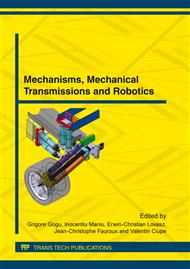[1]
Information on http: /herkules. oulu. fi/isbn9514267508/isbn9514267508. pdf.
Google Scholar
[2]
A.G. Gallagher, E.M. Ritter, H. Champion, G. Higgins, M.P. Fried, G. Moses, C.D. Smith, R.M. Satava, Virtual reality simulation for the operating room: proficiency-based training as a paradigm shift in surgical skills training, Ann surg, 241 (2005).
DOI: 10.1097/01.sla.0000151982.85062.80
Google Scholar
[3]
Y. Aoki, S. Hashimoto, M. Terajima, A. Nakasima, Simulation of postoperative 3D facial morphology using a physics-based head model, The Visual Computer, 17 (2001) 121-131.
DOI: 10.1007/pl00013401
Google Scholar
[4]
J. Xia, H.H.S. Ip, N. Samman, H.T.F. Wong, J. Gateno, D. Wang, R.W.K. Yeung, C.B.S. Kot, H. Tideman, Three-dimensional virtual-reality surgical planning and soft-tissue prediction for orthognathic surgery, IEEE Trans Inf Technol Biomed, 5 (2001).
DOI: 10.1109/4233.924800
Google Scholar
[5]
T. Sohmura, H. Hojo, M. Nakajima, K. Wakabayashi, M. Nagao, S. Iida, T. Kitagawa, M. Kogo, T. Kojima, K. Matsumura, T. Nakamura, J. Takahashi, Prototype of simulation of orthognathic surgery using a virtual reality haptic device. Int J Oral Maxillofac Surg, 33 (2004).
DOI: 10.1016/j.ijom.2004.03.003
Google Scholar
[6]
D. Morris, S. Girod, F. Barbagli, K. Salisbury K, An Interactive Simulation Environment for Craniofacial Surgical Procedures, Health Technol Inform, 111 (2005) 334-341.
Google Scholar
[7]
N. Kusumoto, T. Sohmura, S. Yamada, K. Wakabayashi, T. Nakamura, H. Yatani, Application of virtual reality force feedback haptic device for oral implant surgery, Clin Oral Impl Res, 17 (2006) 708–713.
DOI: 10.1111/j.1600-0501.2006.01218.x
Google Scholar
[8]
K. Kim, J. Park, Virtual Bone Drilling for Dental Implant Surgery Training, Proceedings of the 16th ACM Symposium on Virtual Reality Software and Technology, Kyoto, Japan, (2009) 91-94.
DOI: 10.1145/1643928.1643950
Google Scholar
[9]
J. Forsslund, E.L. Sallnas, K.J. Palmerius, A user-centered designed FOSS implementation of bone surgery simulations, Joint Eurohaptics Conf Symp Haptic Interfaces Virtual Environ Teleoper Syst, (2009) 391-392.
DOI: 10.1109/whc.2009.4810916
Google Scholar
[10]
Q. Wang, H. Chen, J.H. Wu, Y.J. Peng, P.W. Sang, P.A. Heng, Dynamic Touch-enable Bone Drilling Interaction, Proceedings of the 5th International Conference on Information Technology and Application in Biomedicine, in conjunction with The 2nd International Symposium & Summer School on Biomedical and Health Engineering, Shenzhen, China, (2008).
DOI: 10.1109/itab.2008.4570581
Google Scholar
[11]
D. Morris, C. Sewell, N. Blevins, F. Barbagli, K. Salisbury, A Collaborative Virtual Environment for the Simulation of Temporal Bone Surgery, Medical Image Computing and Computer-Assisted Intervention – MICCAI 2004, (2004) 319-327.
DOI: 10.1007/978-3-540-30136-3_40
Google Scholar
[12]
M. Agus, Haptic and Visual Simulation of Bone Dissection, PhD. thesis, Universita degli Studi di Cagliari, Italy, (2004).
Google Scholar
[13]
A. Petersik, B. Pflesser, U. Tiede, K.H. Hӧhne, R. Leuwer, Realistic Haptic Interaction in Volume Sculpting for Surgery Simulation, Comput Biol Med, 37 (2007) 1709 – 1718.
DOI: 10.1007/3-540-45015-7_19
Google Scholar
[14]
M.S. Hsieh, M.D. Tsai, Y.D. Yeh, An Amputation Simulator with Bone Sawing Haptic Interaction, Biomed Eng Appl Basis Comm, 18 (2006) 229-236.
DOI: 10.4015/s1016237206000361
Google Scholar
[15]
M.D. Tsai, M.S. Hsieh, C.H. Tsai, Bone drilling haptic interaction for orthopedic surgical simulator, Comput Biol Med, 37 (2007) 1709-1718.
DOI: 10.1016/j.compbiomed.2007.04.006
Google Scholar
[16]
M. Arbabtafti, M. Moghaddam, A. Nahvi, M. Mahvash, B. Richardson, Physics-Based Haptic Simulation of Bone Machining, IEEE Transaction on Haptics, 4 (2011) 39-50.
DOI: 10.1109/toh.2010.5
Google Scholar
[17]
M. Eriksson, H. Flemmer, J. Wikander, A Haptic and Virtual Reality Temporal Bone Surgery Simulator, Submitted to Advanced Robotics March (2005).
Google Scholar
[18]
S.B. Issenberg, W.C. McGaghie, E.R. Petrusa, D. Lee Gordon, R.J. Scalese, Features and uses of high-fidelity medical simulations that lead to effective learning: a BEME systematic review, Med Teach, 27 (2005) 10-28.
DOI: 10.1080/01421590500046924
Google Scholar
[19]
P.A. Yushkevich, J. Piven, H.C. Hazlett, R.G. Smith, S. Ho, J.C. Gee, G. Gerig, User-guided 3D active contour segmentation of anatomical structures: Significantly improved efficiency and reliability, Neuroimage, 31 (2006) 1116-1128.
DOI: 10.1016/j.neuroimage.2006.01.015
Google Scholar


